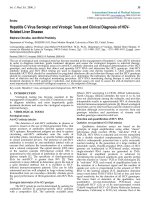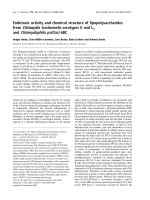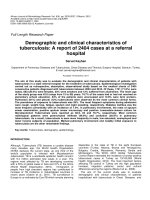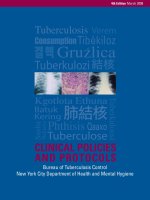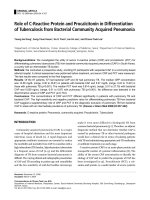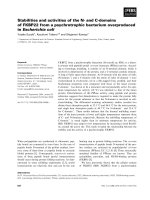Practical and laboratory diagnosis of tuberculosis from sputum smear to molecular biology 2015
Bạn đang xem bản rút gọn của tài liệu. Xem và tải ngay bản đầy đủ của tài liệu tại đây (1.67 MB, 87 trang )
SPRINGER BRIEFS IN MICROBIOLOGY
Guadalupe García-Elorriaga
Guillermo del Rey-Pineda
Practical and Laboratory
Diagnosis of Tuberculosis
From Sputum Smear
to Molecular Biology
123
SpringerBriefs in Microbiology
More information about this series at />
Guadalupe García-Elorriaga
Guillermo del Rey-Pineda
Practical and Laboratory
Diagnosis of Tuberculosis
From Sputum Smear to Molecular Biology
Guadalupe García-Elorriaga
National Medical Center La Raza, CMNR
Mexican Social Security Institute, IMSS
Mexico City, Mexico
Guillermo del Rey-Pineda
Department of Infectology
Federico Gomez Children’s Hospital
Mexico City, Mexico
ISSN 2191-5385
ISSN 2191-5393 (electronic)
SpringerBriefs in Microbiology
ISBN 978-3-319-20477-2
ISBN 978-3-319-20478-9 (eBook)
DOI 10.1007/978-3-319-20478-9
Library of Congress Control Number: 2015944099
Springer Cham Heidelberg New York Dordrecht London
© Springer International Publishing Switzerland 2015
This work is subject to copyright. All rights are reserved by the Publisher, whether the whole or part of
the material is concerned, specifically the rights of translation, reprinting, reuse of illustrations, recitation,
broadcasting, reproduction on microfilms or in any other physical way, and transmission or information
storage and retrieval, electronic adaptation, computer software, or by similar or dissimilar methodology
now known or hereafter developed.
The use of general descriptive names, registered names, trademarks, service marks, etc. in this publication
does not imply, even in the absence of a specific statement, that such names are exempt from the relevant
protective laws and regulations and therefore free for general use.
The publisher, the authors and the editors are safe to assume that the advice and information in this book
are believed to be true and accurate at the date of publication. Neither the publisher nor the authors or the
editors give a warranty, express or implied, with respect to the material contained herein or for any errors
or omissions that may have been made.
Printed on acid-free paper
Springer International Publishing AG Switzerland is part of Springer Science+Business Media
(www.springer.com)
Preface
This book is the result of a joint effort acknowledging the challenge of writing and
publishing a book on the diagnosis of tuberculosis (TB). It is particularly appealing
due to its advantage over other books, since it specifically focuses on the diagnosis of
TB, encompassing the elemental diagnostic methods up to cutting-edge technologybased tests, including the diagnosis of TB infection (latent TB infection, LTBI).
This treaty is exclusively centered on the diagnosis of TB, including the spectrum of clinical diagnosis through the microbiological and molecular gold standard,
the most practical, due to its celerity and high sensitivity. The diagnosis of LTBI,
key to TB control, is also addressed.
Since TB diagnostic methods are still evolving, training must also be continuous.
Great advances in this dynamic and ever-changing field have developed in the past
few years, particularly resulting from the introduction of Molecular Biology. But
unfortunately, this has led to increased costs and hence great disadvantages, leaving
many patients without a timely diagnosis and appropriate treatment, particularly in
highly endemic countries.
With comprehensive mastery, a change in the paradigm on TB diagnosis could
well revitalize the required technology, making it more efficient, faster, predictable,
and at a more accessible cost.
A century after Robert Koch discovered the bacillus causing TB, a great number
of countries still depend on bacilloscopy as the only means of disease detection. We
build on the past and we are all a product of our parents, professors, and colleagues
as well as of our God-given talents and challenges.
I have had the privilege of working on the routine microbiological diagnosis of
TB at the Laboratorio de Microbiología de la Unidad Médica de Alta Especialidad
“Dr. Gaudencio González Garza,” all the way to the Molecular Biology techniques
in the Immunology and Infectious Disease Research Unit of the Infectious Disease
Hospital at the Centro Médico Nacional “La Raza,” affiliated with the Instituto
Mexicano del Seguro Social.
We believe that particularly in countries with high TB endemicity, a quick and
handy reference book on the diagnosis of TB is useful for Clinicians, Microbiologists,
teachers and students of Medicine and Microbiology.
v
vi
Preface
I wish to express my gratitude to many colleagues and physicians for their support and close collaboration, particularly during those fruitful meetings of the
Center for National Epidemiological Surveillance and Disease Control (Centro
Nacional de Vigilancia Epidemiológica y Control de Enfermedades). Also, to the
Dirección General de Epidemiología. SS, primarily for the “Modification of the
Mexican Official Policy NOM-006-SSA2-1993,” for the prevention and control of
tuberculosis at the primary health care level, published in the Diario Oficial on
September 27, 2005; and secondly, for the elaboration of the “Practical guide to the
care of tuberculosis in children and adolescents,” in association with the National
Tuberculosis Program, ISBN 970-721-334-5. December 2006.
I must also especially acknowledge all those silent heroes that have been of great
assistance in the preparation of this manuscript: Gabriel Natan Pires, the Clinical
Medicine Associate Editor that wholly believed in the Project; the always patient and
kind Associate Editor at Life Sciences and Biomedicine at Springer Brazil, Roberta
Gazzarolle Del Rossi, and our attentive project coordinator, Susan Westendorf.
My coauthor, Dr. Guillermo del Rey-Pineda, an expert Immunologist, and I hope
that our initiative will motivate the interest of our readers not only in the solution of
TB clinical diagnostic dilemmas but to prompt them to present new questions on
routine and basic diagnosis, fostering a continuous bidirectional exchange between
the realms of health care and those of clinical and basic research.
Mexico DF, Distrito Federal, Mexico
Guadalupe García-Elorriaga
Contents
1
Introduction .................................................................................................
1
2
Clinical Diagnosis ........................................................................................
2.1 A Complete Medical Evaluation for Tuberculosis (TB)
Includes the Following Five Components ...........................................
2.1.1 Medical History .......................................................................
2.1.2 Physical Examination...............................................................
2.1.3 Test for TB Infection ................................................................
2.1.4 Chest X-Ray .............................................................................
2.1.5 Bacteriologic Examination of Clinical Specimens ..................
2.2 Other Tests ...........................................................................................
2.2.1 Adenosine Deaminase (ADA) .................................................
2.2.2 Histopathology .........................................................................
2.3 Evaluation of Diagnostic Methods in EPTB........................................
2.3.1 Diagnosis of Miliary TB ..........................................................
2.3.2 Diagnosis of Pleural TB ...........................................................
2.3.3 Diagnosis of Meningeal TB .....................................................
2.3.4 Diagnosis of Pericardial TB .....................................................
2.3.5 Diagnosis of Lymph Node TB .................................................
2.3.6 Diagnosis of Abdominal TB ....................................................
2.3.7 Diagnosis of Resistance to Anti-TB Drugs ..............................
References .....................................................................................................
7
3
Bacteriological Diagnosis............................................................................
3.1 Sampling Methods ...............................................................................
3.1.1 Importance of Sample Collection and Processing
in Pulmonary TB ......................................................................
3.1.2 Specimen Collection Methods in Extrapulmonary TB ............
3.1.3 Acid-fast Bacilli Smear Classification and Results .................
3.1.4 Evolution of the Microbiological Techniques
Used to Diagnose Tuberculosis................................................
8
8
8
9
9
11
11
11
12
14
14
16
16
16
16
17
17
17
19
19
20
20
21
21
vii
viii
Contents
3.1.5
Conventional Microbiological Techniques
in the Diagnosis of Tuberculosis ..............................................
3.1.6 Smear Microscopy ...................................................................
3.1.7 Auramine–Rhodamine Fluorescent Staining ...........................
3.1.8 Light-Emitting Diode Microscopy...........................................
3.2 Culture Methods...................................................................................
3.2.1 LJ Culture.................................................................................
3.2.2 Liquid Culture, DST ................................................................
3.2.3 MB/BacT System .....................................................................
3.2.4 The MGIT ................................................................................
3.2.5 Non-commercial Culture Methods ..........................................
3.2.6 Newer Solid Cultures ...............................................................
3.3 Identification of Mycobacteria .............................................................
3.3.1 Reporting Results .....................................................................
3.3.2 In Vitro MTB Drug Susceptibility Testing...............................
3.3.3 Diagnosis of Active TB ............................................................
3.3.4 Volatile Organic Compounds ...................................................
3.3.5 Breath Sample Collection ........................................................
3.3.6 Breath Sample Analysis ...........................................................
3.3.7 Active Non-PTB ......................................................................
References .....................................................................................................
4
Molecular Diagnosis....................................................................................
4.1 Introduction ..........................................................................................
4.2 Nucleic Acid Amplification Test ..........................................................
4.2.1 PCR ..........................................................................................
4.2.2 Line Probe Assays (LPAs) (INNO-LiPA Rif
TB Assay, MTBDRsl) ..............................................................
4.2.3 GeneXpert ................................................................................
4.2.4 Policy Updates .........................................................................
4.2.5 Implementation of Existing Technologies ...............................
4.2.6 Planned Technology Refinements of GeneXpert .....................
4.3 Other Isothermal NAATs .....................................................................
4.3.1 Transcription Mediated Amplification/Nucleic Acid
Sequence Based Amplification ................................................
4.3.2 Simple Method for Amplifying RNA Targets ..........................
4.3.3 Recombinase Polymerase Amplification .................................
4.3.4 Helicase-Dependent Amplification ..........................................
4.3.5 Rolling Circle Amplification ....................................................
4.3.6 Ramification-Extension Amplification.....................................
4.3.7 Loop-Mediated Isothermal Amplification................................
4.3.8 Cross-Priming Amplification ...................................................
4.3.9 Smart Amplification Process (SmartAmp)...............................
22
22
23
24
24
24
26
26
26
27
27
27
28
29
30
30
30
31
31
33
35
35
37
38
38
38
39
40
41
42
42
43
44
44
45
46
47
48
49
Contents
5
ix
4.3.10 Strand Displacement Amplification .......................................
4.3.11 Nicking Enzyme Amplification Reaction...............................
4.3.12 Nicking Enzyme-Mediated Amplification (NEMA) ..............
4.3.13 Isothermal Chain Amplification .............................................
4.3.14 Exponential Amplification Reaction ......................................
4.3.15 Limitations of Amplification Tests .........................................
4.3.16 Future Perspectives ................................................................
4.4 Conclusions ..........................................................................................
References .....................................................................................................
49
50
50
50
51
51
51
51
53
TB Infection .................................................................................................
5.1 Introduction ..........................................................................................
5.2 Tuberculin Skin Test ............................................................................
5.2.1 Tuberculin ..............................................................................
5.2.2 Pathogenic Basis of TST ........................................................
5.2.3 Immunological Bases of the Tuberculin Reaction .................
5.2.4 Factors Influencing the Test Result ........................................
5.2.5 False Negative Readings ........................................................
5.2.6 False Positive Readings..........................................................
5.2.7 Boosted Reaction and Serial Tuberculin Skin Testing ...........
5.2.8 Previous BCG Vaccination .....................................................
5.2.9 Definition of TST Conversions ..............................................
5.2.10 Anergy Test in HIV-Infected Individuals ...............................
5.2.11 TST Indications ......................................................................
5.3 IFNγ Detection (IGRA) .......................................................................
5.3.1 Immune Response to TB Infection ........................................
5.3.2 General Recommendations for the Use of IGRA...................
5.3.3 Types of IGRA .......................................................................
5.3.4 Test Performance and Interpretation ......................................
5.3.5 Advantages of IGRA Over TST .............................................
5.3.6 Sensitivity and Specificity ......................................................
5.3.7 Clinical Performance of IGRA...............................................
5.3.8 IGRA in Immunosuppressed Patients ....................................
5.3.9 Cost-Effectiveness..................................................................
5.3.10 International Guidelines on IGRA Use ..................................
References .....................................................................................................
55
55
57
58
58
58
59
63
63
64
64
64
65
65
65
66
66
68
68
68
69
70
70
71
71
72
Index ................................................................................................................... 73
Abbreviations
ADA
AFB
ATB
ATD/GC/MS
BAL
BCA
BCG
CD1
CDC
CFP-10
CPA
CRI
CT
CXR
DNA
DST
DTH
EPTB
ESAT-6
FDA
FIND
HDA
HIV
HRCT
ICT
IGRA
IFNγ
IL-1b
IL-12
IL-15
Adenosine deaminase
Acid fast bacteria
Active tuberculosis
Automated thermal desorption, gas chromatography,
and mass spectroscopy
Bronchoalveolar lavage
Breath collection apparatus
Bacilo de Calmette-Guérin
Cluster of differentiation 1
Centers for Disease Control and Prevention (USA)
Culture filtrate protein 10
Cross priming amplification
Colorimetric redox indicator
Computed tomography
Chest X-ray
Deoxyribonucleic acid
Drug susceptibility testing
Delayed-type hypersensitivity
Extrapulmonary tuberculosis
Early secretory antigenic target 6
Food and Drug Administration (USA)
Foundation for Innovative New Diagnostics
Helicase-dependent amplification
Human immunodeficiency virus
High resolution computed tomography
Immunochromatography test
Interferon gamma release assay
Interferon gamma
Interleukin-1 beta
Interleukin-12
Interleukin-15
xi
xii
IL-18
ISTC
LAMP
LED
LJ
LPA
LRP
LTBI
MDCT
MDR-TB
MGIT
MODS
MRI
MTB
MTBC
MVL
NAAT
NK
NEAR
NRA
NTM
PCR
PEPFAR
PET
POCT
PPD
PTB
RAM
RCA
RD1
RNA
RPA
SDA
SMART
SmartAmp
TB
TBLB
TLA
TMA
TNFα
TPE
TST
USAID
Abbreviations
Interleukin-18
International Standards for Tuberculosis Care
Loop-mediated amplification
Light-emitting diode
Lowenstein–Jensen media. A solid culture media used for
tuberculosis diagnosis
Line probe assay
Luciferase reporter phage
Latent TB infection
Multidetector-computed tomography
Multidrug-resistant tuberculosis
Mycobacteria Growth Indicator Tube
Microscopic-observation drug-susceptibility
Magnetic resonance imaging
Mycobacterium tuberculosis
Mycobacterium tuberculosis complex. A genetically related group
of Mycobacterium that cause tuberculosis
Mercury vapor lamp
Nucleic acid amplification test
Natural killer
Nicking enzyme amplification reaction
Nitrate reductase assay
Non-TB mycobacteria
Polymerase chain reaction
United States President’s Emergency Plan for AIDS Relief
Positron emission tomography
Point-of-care testing
Purified protein derivative
Pulmonary tuberculosis
Ramification-extension amplification
Rolling circle amplification
Region of difference
Ribonucleic acid
Recombinase polymerase amplification
Strand displacement amplification
Simple method for amplifying RNA targets
Smart amplification process
Tuberculosis
Transbronchial lung biopsy
Thin layer agar
Transcription mediated amplification
Tumor necrosis factor alpha
Tuberculous pleural effusion
Tuberculin skin test
United States Agency for International Development
Abbreviations
VOC
WHO
XDR-TB
ZN
Volatile organic compounds
World Health Organization
Extensively drug-resistant tuberculosis
Ziehl–Neelsen staining
xiii
Chapter 1
Introduction
Abstract The purpose of diagnostic guidelines for tuberculosis (TB) is to describe
an acceptable level for all public and private professionals; they should try to achieve
the proper diagnosis of patients who have, or suspected of having, or are at increased
risk of developing TB. The basic principles of care for persons with, or suspected of
having, TB are the same worldwide: a diagnosis should be established promptly and
accurately; should use standardized treatment regimens proven, along with appropriate treatment support and supervision; response to treatment should be monitored; and the essential public health responsibilities must be carried out. The
contribution of microbiology laboratory for diagnosis and management of TB is: (1)
Collection of specimens for demonstration of tubercle bacilli; (2) Transport of specimens to the laboratory; (3) Digestion and decontamination of specimens; (4)
Staining and microscopic examination; (5) Identification of mycobacteria directly
from clinical specimens (nucleic acid amplification techniques (NAAT); (6)
Cultivation of mycobacteria; (7) Identification of mycobacteria from culture; and
(8) Drug susceptibility testing (DST). To identify Mycobacterium tuberculosis
(MTB) in people without the disease, the methods used are the tuberculin skin test
(TST) and the Interferon-gamma release assay (IGRA).
Keywords DST • IGRA • MTB • NAAT • TB • TST
Diagnostic guidelines are designed to provide a frame of reference to understand the
diagnosis of infection/disease due to tuberculosis (TB), and present a classification
outline that may simplify the management of individuals undergoing diagnostic
testing.
The specific objectives of this volume are the following:
1. To define diagnostic strategies in high and low risk patient populations, based on
current knowledge of the epidemiology of TB and information on new
technologies.
This edition was prepared as a practical guide for microbiologists, physicians, health organizations, and educational institutions involved in the care of patients with TB. References have been
included to guide the reader to texts and journal articles to obtain further detailed information on
each subject.
© Springer International Publishing Switzerland 2015
G. García-Elorriaga, G. del Rey-Pineda, Practical and Laboratory
Diagnosis of Tuberculosis, SpringerBriefs in Microbiology,
DOI 10.1007/978-3-319-20478-9_1
1
2
1
Introduction
2. Promote a precise diagnosis and hence, the administration of curative medical
therapy.
The diagnosis of TB should hinge on a series of ancillary methods and confirmatory microbiological techniques. Ancillary diagnostic methods are nonspecific and
include clinical manifestations, imaging findings (highly sensitive), histopathology
(more specific than the other approaches), and the tuberculin skin test (TST) (a
small contribution in terms of diagnosis).
When facing a possible case of disease due to TB, it is presumed that the infection by M. tuberculosis (MTB) has progressed enough to where clinical manifestations have developed, forcing the host/patient to seek medical help. Therefore, it is
necessary to be familiar with the clinical picture of TB and with the relevant diagnostic techniques.
TB lacks specific clinical manifestations that can easily differentiate it from
other respiratory diseases. In most cases, clinical manifestations in the TB setting
are insidious and not particularly alarming; as a result, several months may go by
before the diagnosis is established.
MTB may spread to any part of the body since it first enters the host. In summary,
TB may affect any organ or tissue.
Aside from pulmonary involvement, the most common extrapulmonary sites of
the disease include (in decreasing order): pleural, lymphatic, urogenital, osteoarticular, and meningeal, although as previously mentioned, any organ or tissue may
be compromised. In immunocompetent patients, the frequency of extrapulmonary
TB (EPTB) is no greater than 15–20 %, but this number increases in immune deficiency states as in the case of AIDS patients in whom extrapulmonary disease
accounts for 50–60 % of all TB cases.
The physical examination of patients with TB disease also lacks specificity and
frequently contributes scarce data to the diagnosis. In many cases, the patient
appears healthy.
Also, laboratory testing does not provide characteristic information although
tests should always be obtained for diagnostic purposes and in some cases, for
patient follow-up during treatment.
The chest X-ray is a very sensitive technique in the diagnosis of PTB in immunocompetent individuals, although it is nonspecific since TB is not associated to
pathognomonic radiological findings, regardless of how suggestive the images are.
Although there are radiographic images that can greatly suggest the possibility of
TB, these findings are only inferential support to the diagnosis and require the performance of confirmatory microbiological evaluations. The role of the chest X-ray
in the TB diagnostic algorithm depends on the available resources and on the disease’s prevalence in a specific population. In wealthy countries, radiological evaluation and microscopy are both recommended in all cases of suspected TB.
The value of the TST is very limited in the diagnosis of TB. But in children,
especially if under the age of 5 and in whom the prevalence of MTB infection is
very low, a positive test points to a very recent infection or real disease. In certain
cases of a negative bacilloscopy and if EPTB hematogenous dissemination is suspected, biopsies may be required. The diagnosis is then based on the identification
1
Introduction
3
of caseous granulomas that may nevertheless be due to other disease processes,
particularly as a result of other environmental mycobacteria or certain fungi.
Sampling and management of fluids and tissues affect the sensitivity of the different microbiological techniques. If possible, samples should be obtained before
initiating chemotherapy and in open or well-ventilated areas.
In spite of the breakthroughs over the past 30 years in terms of microbiological
TB diagnostic techniques, only a small segment of the population worldwide has
benefitted. In low- and middle-income countries, the main diagnostic method is
bacilloscopy with Ziehl–Neelsen’s technique, due to its simplicity, rapidity, reproducibility, low cost, and efficacy in the detection of infectious cases.
The other basic TB diagnostic technique is culture, the only available method
that can establish a definitive diagnosis and useful in patient follow-up and to ensure
a definitive cure. Moreover, culture has greater sensitivity than bacilloscopy.
In terms of identification of the different mycobacterial strains, biochemical
techniques such as chromatography and genetic probes are available. However,
these biochemical tests are only routinely used in low- or middle-income countries
due to their lower costs, although they may be complicated and slow to perform and
they lack reproducibility.
In low- or middle-income countries, drug sensitivity must be tested following
Canetti’s proportions method and on Lowenstein–Jensen medium. Readout is conducted after 4–5 weeks and the laboratory must inform the physician on the amount of
growth in media supplemented with anti-TB drugs compared to media with no drug.
The discovery of the structure of DNA, the elucidation of genetic molecular
mechanisms, and the development of the polymerase chain reaction (PCR) have
yielded powerful methods for the diagnosis of infectious disease. In spite of these
advances, the gold standard for microbial identification is still culture and subsequent phenotypic differentiation of the causal pathogen.
TB diagnostic tests based on nucleic acid amplification (NAAT) are based on the
amplification of specific short DNA or RNA sequences of the MTB complex with
PCR; the amplified products are then detected by agarose/acrylamide gel electrophoresis or with various hybridization methods.
NAAT ensures a fast, sensitive, and specific diagnosis of infectious diseases. The
next generation of diagnostic devices will focus on the genetic determinants of these
disease at the point-of-care, so physicians can provide a quick and dependable diagnosis and hence, a more effective treatment.
Undoubtedly, molecular technology has yielded very powerful diagnostic tools.
The diagnostics industry has recognized the many benefits of NAAT and is steadily
investing in molecular diagnostic methods.
NAAT instrumentation has been miniaturized, fostering the equipment’s portability. NAAT is particularly powerful in the prompt identification of pathogens
whose prodromal presentation is similar but whose treatment strategies are entirely
different.
In adults suspected of harboring TB, with or without associated HIV infection, it
has been found that the MTB/RIF kit is sensitive and specific for TB detection. The
Xpert MTB/RIF (GeneXpert) method is also valuable as a diagnostic tool in addition to bacilloscopy (sensitivity 67 %).
4
1
Introduction
Using the GeneXpert kit for the diagnosis of multidrug-resistant TB (MDR TB)
would cost less (US$70 to 90 million per year) than using a combination of conventional diagnostic methods (US$123 to 191 million per year). Conventional diagnostic
methods include bacilloscopy, chest X-ray, culture, and drug susceptibility testing
(DST) based on culture results and following the algorithms recommended by the
WHO.
Specific tests are a strategy for TB control used to identify, evaluate, and treat
individuals at high risk for latent TB infection (LTBI) or at high risk of developing
the disease once infected with MTB. The identification of individuals with latent
infection is pivotal for the control and elimination of TB, since treatment of LTBI
may prevent infected individuals from developing the disease and also contribute to
the arrest of TB propagation.
Other services (i.e., correctional institutions) must consult their local health
departments before initiating a screening program in order to ensure the availability
of resources for the evaluation and treatment of individuals testing positive for latent
infection or TB disease. There are currently two methods for TB detection in the
United States: (1) Mantoux TST and (2) Interferon-gamma release assay (IGRA).
A negative reaction to either test does not preclude LTBI or TB disease. Medical
management or public health decisions must take into account clinical, epidemiological, historic, and other information when IGRA or TST is positive; the decisions
should not be solely based on the TST or IGRA results.
TST is used to determine whether an individual is infected with MTB. In this
test, a substance known as purified protein derivative (PPD) derived from tuberculin
is injected under the skin. After 2–8 weeks since the initial TB infection, the immune
system reacts to the PPD and the infection can be detected with the TST. TST
involves the intradermal injection of 0.1 mL PPD containing 5 tuberculin units, on
the volar surface of the arm.
The TST must be read 48–72 h after the injection, by a health worker trained in
TST result interpretation.
The TST is read by palpation of the injection site, searching for an area of induration (firm swelling). The indurated area’s diameter should be measured on the
forearm.
The interpretation of TST reactions hinges on the size (in millimeters) of the
induration and the risk of acquiring the infection or of progression to TB disease if
the individual is infected. Individuals that have been previously vaccinated with
BCG may develop a positive reaction to TST even if they have no TB infection.
Some individuals have a negative TST reaction in spite of a present MTB infection. False negative TST reactions may occur if infection developed within 8 weeks
of the skin test.
The booster effect is mostly present in previously infected elderly individuals
whose ability to react to tuberculin has faded over time. The two-step test refers to
a strategy used to decrease the probability of misinterpreting a booster reaction as a
recent infection.
1
Introduction
5
IGRA detects MTB infection by measuring the immune response to TB proteins
in whole blood. IGRA is unable to differentiate between a latent infection and active
disease.
IGRA may be used for surveillance purposes or to identify individuals that could
probably benefit from treatment, including those at higher risk of TB disease
progression if infected with MTB. IGRA may be used instead of (but not in addition
to) TST in all situations in which the Centers for Disease Control and Prevention
(CDC) recommend it as a TB infection diagnostic aid.
Chapter 2
Clinical Diagnosis
Abstract A complete medical evaluation for tuberculosis (TB) includes the
following: (1) Medical history, (2) Physical examination, (3) Tests for TB Infection,
(4) Chest radiograph, and (5) Diagnostic microbiology. Tuberculin skin testing
(TST) is the most common method used to screen for latent M. tuberculosis infection (LTBI). In 2001, an interferon release assay (QuantiFERON-TB test) was
approved by the Food and Drug Administration (FDA). Active tuberculosis (ATB)
is considered as a possible diagnosis when findings in a chest radiograph of a patient
being evaluated for respiratory symptoms are abnormal, as occurs in most patients
with pulmonary tuberculosis (PTB). The radiographs may show the characteristic
finding of infiltrates with cavitation in the upper and middle lobes of the lungs,
including clinical suspicion and response to treatment. Traditionally, the first laboratory test used to detect ATB in a patient with an abnormal chest radiograph is
examination of a sputum smear in search for acid-fast bacilli (AFB). Definitive
diagnosis of TB requires the identification of M. tuberculosis (MTB) in the culture
of a diagnostic specimen. The most frequent sample obtained from a patient with a
persistent and productive cough is sputum. Sputum is obtained by bronchoscopy
and bronchial washings or bronchoalveolar lavage. Newer and faster MTB diagnostic techniques include nucleic acid amplification (NAA) tests. With molecular biology methods, DNA and RNA are amplified thus facilitating rapid detection of
microorganisms; these tests have been approved by the FDA. Biopsy and/or surgery
are required to procure tissue samples for diagnosis of extrapulmonary TB (EPTB).
Keywords Chest radiograph • Diagnostic microbiology • Histopathology • Medical
history • Physical examination • Tests for TB Infection
© Springer International Publishing Switzerland 2015
G. García-Elorriaga, G. del Rey-Pineda, Practical and Laboratory
Diagnosis of Tuberculosis, SpringerBriefs in Microbiology,
DOI 10.1007/978-3-319-20478-9_2
7
8
2.1
2.1.1
2
Clinical Diagnosis
A Complete Medical Evaluation for Tuberculosis (TB)
Includes the Following Five Components
Medical History
When conducting a medical history, the clinician should ask if any symptoms of TB
are or have been present; if so, for how long, and whether there has been any known
exposure to individuals with infectious TB. Equally important is whether or not the
individual has been diagnosed in the past with latent TB infection (LTBI) or classic
TB. Clinicians should determine if the patient has any underlying medical conditions, especially human immunodeficiency virus (HIV) infection or diabetes, that
increase the risk of progression to active TB in those latently infected with M. tuberculosis (MTB) [6].
TB most commonly affects the lungs and is referred to as pulmonary TB (PTB).
PTB often leads to general signs and symptoms, including cough (especially if lasting for 3 weeks or longer) with or without sputum production, coughing up blood
(hemoptysis), chest pain, loss of appetite, unexplained weight loss, night sweats,
fever, and fatigue.
Extrapulmonary TB (EPTB) may cause symptoms related to the compromised
organ or system. For example, TB of the spine may cause back pain, TB of the kidney may be manifested as blood in the urine, or meningeal TB may lead to headache
or confusion. Both PTB and EPTB symptoms can be caused by other diseases but
should always prompt the clinician to consider a diagnosis of TB.
2.1.2
Physical Examination
The physical examination is an essential part in the evaluation of any patient. It cannot be used to confirm or rule out TB, but it can provide valuable information on the
patient’s overall condition, point to a specific diagnostic method and reveal other
factors that may affect the treatment of TB, if so diagnosed. Physical findings are
usually absent in mild or moderate disease. Dullness with decreased fremitus may
indicate pleural thickening or effusion. In many instances, the patient appears to be
healthy. Nevertheless, a systematic examination is always required in the search of
possible diagnostic clues such as:
Crackling rales in the infraclavicular space or in the interscapulo-vertebral area due
to exudative and cavitary lesions.
Uni- or bilateral bronchial rales (rhonchi, subcrepitations) in case of bronchogenic
disease dissemination.
In case of pleural involvement, there is dullness on percussion and absence or
decrease of vesicular murmur.
2.1
A Complete Medical Evaluation for Tuberculosis (TB) Includes…
2.1.3
9
Test for TB Infection
Selection of the most suitable tests for detection of MTB infection should be based on
the reasons and the context for testing, test availability, and overall cost-effectiveness.
Currently, there are two available methods for the detection of MTB infection:
Mantoux tuberculin skin test (TST) and Interferon-gamma (IFNγ) release assays
(IGRAs), such as the enzyme-linked immunosorbent assay (QuantiFERON-TB Gold
In-Tube (QFT-GIT), Cellestis Limited, Carnegie, Victoria, Australia) and the enzymelinked immunospot assay (T-SPOT®.TB, Oxford Immunotec, Oxford, UK) [5, 8].
TST is the standard method of determining whether a person is infected with
MTB. Reliable administration and reading of the TST requires standardization of
procedures, training, supervision, and practice in Chap. 5.
For the first time, an alternative to the TST has emerged in the form of a new type
of in vitro T-cell-based assay: IGRA. IGRAs are based on the principle that the
T-cells of individuals sensitized with TB antigens produce IFNγ when they reencounter mycobacterial antigens in Chap. 5 [2, 3].
2.1.4
Chest X-Ray
All patients with persistent cough of more than 3 weeks duration should have a
chest radiograph to rule out, among other diseases, PTB. Since PTB is the most
common form of the disease, a chest X-ray (CXR) is useful in its diagnosis of
TB. Chest abnormalities can suggest pulmonary TB. In some instances, a computerized tomography (CT) scan may provide additional information. A CT scan provides more detailed images that cannot be easily seen on a standard chest radiograph;
however, CT scans can be substantially more expensive. In PTB, radiographic
abnormalities are often seen in the apical and posterior segments of the upper lobe
or in the superior segments of the lower lobe. However, lesions may appear anywhere in the lungs and may differ in size, shape, density, and cavitation, especially
in HIV-infected and other immunosuppressed hosts. Often, the only vestige of a
primary infection is a positive TST and the Ranke complex (Fig. 2.1).
The clinical and radiological suspicion of PTB is sufficient to initiate treatment
without awaiting the culture result, but sputum should be obtained before the administration of therapy.
Mixed nodular and fibrotic lesions may contain slowly multiplying tubercle
bacilli with the potential for progression to full-blown TB. Individuals with radiographic lesions suggesting “old” TB and with a positive TST reaction or positive
IGRA should be considered high-priority candidates for treatment of LTBI, but only
after active TB (ATB) is excluded in three specimens tested for acid-fast bacilli
(AFB) by smear and culture because “old” TB cannot be differentiated from ATB
on the basis of radiographic findings alone.
10
2
Clinical Diagnosis
Fig. 2.1 Radiographic residuals of primary infection
In HIV-infected individuals, PTB may present with atypical findings or with no
obvious lesions on the CXR. The radiographic appearance of PTB in individuals
infected with HIV might be typical; however, cavitary disease is less common
among such patients. Abnormalities on CXR radiographs may be suggestive of, but
are never diagnostic of TB. CXR may be used to exclude PTB in an HIV-negative
patient who has a positive TST reaction or IGRA and no symptoms or signs of
TB. For practical purposes, a normal CXR excludes TB.
The following CXR shadows are strongly suggestive of TB:
Upper lung patchy or nodular shadows (on one or both sides).
Cavitation (particularly if there is more than one cavity). Calcified shadows may
lead to diagnostic difficulties. Remember that pneumonia and lung tumors can
occur in areas of previous healed and calcified TB. Some benign tumors may
also be calcified.
Other shadows that may be due to TB are:
Oval or round solitary shadow (tuberculoma).
Hilar and mediastinal shadows due to enlarged lymph nodes (persisting primary
complex).
Diffuse, small, nodular shadows (miliary TB).
The correct reading of a CXR requires significant experience. If you suspect TB
based on the X-ray but the sputum is negative, administer a non-TB antibiotic (e.g.,
ampicillin, oxytetracycline) for 7–10 days and then obtain another CXR. Shadows
due to acute pneumonia will have improved.
11
2.2 Other Tests
Table 2.1 Usefulness of chest radiography as a diagnostic test for TB
Radiographic finding
Any abnormalities consistent with TB (active or inactive)
Abnormalities suggestive of active TB
After screening positive symptoms (one study)
Sensitivity (%)
98 (95–100)
87 (79–95)
90 (81–96)
Specificity (%)
75 (72–79)
89 (87–92)
56 (54–58)
In individuals with a negative smear and PTB symptoms, an abnormal CXR may
be very useful diagnostically. However, a diagnosis of TB can not be established
only by radiography. Although the sensitivity of CXR is high, the specificity is low,
as shown in Table 2.1.
2.1.5
Bacteriologic Examination of Clinical Specimens
Examination of clinical specimens (e.g., sputum, urine, or cerebrospinal fluid) is of
critical diagnostic importance. The specimens should be examined and cultured in
a laboratory that specializes in testing for MTB. The bacteriologic examination
includes five stages: (1) Specimen collection, processing, and review; (2) AFB
smear classification and results; (3) Direct detection of MTB in the clinical specimen with a nucleic acid amplification test (NAAT); (4) Specimen culture and identification; and (5) Drug susceptibility testing.
2.2
2.2.1
Other Tests
Adenosine Deaminase (ADA)
EPTB accounts for 10 % of all cases and pleural TB is the second most common
manifestation, preceded only by lymphonodular TB. The diagnosis of the first condition is established by bacteriological means and identifying the bacillus in pleural
fluid; unfortunately, staining when in search of MTB is usually negative and culture
is positive in less than 25 % of cases. Furthermore, a pleural biopsy only shows
granulomatous pleuritis in 80 % of patients with tuberculous pleural effusion (TPE)
[4]; biopsy culture combined with histological examination, establishes the diagnosis in approximately 90 % of cases.
Measurement of ADA activity has proven to be sensitive (73 %) and specific
(90 %) for pleural TB in special circumstances, such as in regions with a high prevalence of TB. The levels of ADA, an enzyme found in most cells, are increased in
TPEs; this determination has acquired popularity as a diagnostic test in areas with a
high incidence of TPE because it is noninvasive, the assay is not expensive, and it is
12
2
Clinical Diagnosis
readily accessible. The demonstration of elevated pleural fluid ADA levels is useful
in establishing the diagnosis of tuberculous effusions. ADA is an enzyme involved
in purine catabolism, catalyzing the conversion of adenosine to inosine. The colorimetric test is based on the quantification of ammonium yielded as a result of the
enzymatic activity. The reported cutoff value for ADA varies from 47 to
60 U/L. Specificity is increased when the lymphocyte/neutrophil ratio in pleural
fluid (>0.75) is weighed in association with an ADA concentration >50 U/L. Exudative
lymphocytic pleural effusions are commonly encountered in clinical practice and
are often a challenging diagnostic problem. The two most common causes are
malignancy and tuberculous effusions, making the test less useful in countries with
a low prevalence of TB.
With the declining prevalence of PTB, the positive predictive value of pleural
fluid ADA has also decreased although its negative predictive value has actually
increased. Therefore, the measurement of pleural fluid ADA levels can be used to
rule out a tuberculous etiology of lymphocytic pleural effusions, regardless of the
prevalence of TB.
This test is mostly used to confirm the diagnosis if disease is suspected rather
than to rule it out.
2.2.2
Histopathology
The multiplication of tubercle bacilli at any site causes a specific type of inflammation, with formation of the characteristic granuloma (Fig. 2.2). Pathology analysis
involves examining the tissue for suspected TB [1]. Histopathology entails the
microscopic examination of a tissue sample and it is a diagnostic aid when bacteriological techniques cannot be applied. It is especially useful for EPTB.
Types of samples: (1) Aspiration of the lymph nodes; (2) Biopsy of the serous
membranes; and (3) Tissue biopsy: (a) Without surgery; (b) During surgery; and (c)
Postmortem.
Methods: (1) Cytological techniques; (2) Bacteriological and histological techniques on biopsied samples; (3) Bacteriological techniques; and (4) Histology
techniques.
Practical point: on biopsy, at least two fragments should be collected; one is
placed in saline solution and transferred to the mycobacteriology laboratory for
culture, while the other undergoes fixation for histological evaluation.
Microscopic aspects: Organ involvement by TB leads to an inflammatory reaction in the affected site. Inflammation develops in three successive stages that can
overlap—acute, subacute, and chronic—and that have different histological
characteristics.
Practical point: among all types of lesion, only follicular lesions with necrotizing
granulomas are specific enough to confirm the diagnosis of TB, as is detection of
bacilli on histological samples after appropriate staining.
